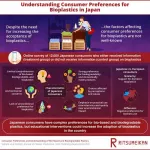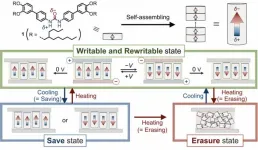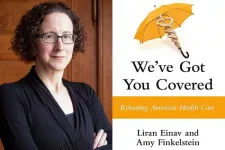(Press-News.org)
Having a food allergy as a baby is linked to asthma and reduced lung function later in childhood, according to a world first study.
The research, led by Murdoch Children’s Research Institute and published in the Lancet Child & Adolescent Health, found that early life food allergy was associated with an increased risk of both asthma and reduced lung growth at six years of age.
Murdoch Children’s Associate Professor Rachel Peters said this was the first study to examine the relationship between challenge-confirmed food allergy in infancy and asthma and poorer lung health later in childhood.
The Melbourne research involved 5276 infants from the HealthNuts study, who underwent skin prick testing to common food allergens, including peanut and egg and oral food challenges to test for food allergy. At six years, children were followed up with further food allergy and lung function tests.
The study found by six years of age, 13.7 per cent reported a diagnosis of asthma. Babies with a food allergy were almost four times more likely to develop asthma at six years of age, compared to children without a food allergy. The impact was greatest in children whose food allergy persisted to age six as opposed to those who had outgrown their allergy. Children with a food allergy were also more likely to have reduced lung function.
Associate Professor Peters said food allergy in infancy, whether it resolved or not, was linked to poorer respiratory outcomes in children.
“This association is concerning given reduced lung growth in childhood is associated with health problems in adulthood including respiratory and heart conditions,” she said.
“Lung development is related to a child’s height and weight and children with a food allergy can be shorter and lighter compared to their peers without an allergy. This could explain the link between food allergy and lung function. There are also similar immune responses involved in the development of both food allergy and asthma.
“The growth of infants with food allergy should be monitored. We encourage children who are avoiding foods because of their allergy to be under the care of a dietician so that nutrition can be catered for to ensure healthy growth.”
Food allergy affects 10 per cent of babies and 5 per cent of children and adolescents.
Suba Slater’s, son Zane, 15, is allergic to eggs, sesame and peanuts and has asthma.
“As a newborn he developed eczema on his back and I thought because I was breastfeeding, there was something in my diet causing the rash,” she said. “We took him into hospital for tests, which confirmed the multiple food allergies.”
Suba said she wasn’t well informed of the link between food allergy and asthma prior to Zane’s diagnosis.
“We were very focused and vigilant around the food allergy aspect given our eldest child also has allergies,” she said. Having this link shown through this research and making parents and medical professionals aware of it is extremely important. After we discovered Zane had food allergies we didn’t know to lookout for asthma and it wasn’t on our radar.
“Looking back, he most likely had asthma long before we could hear that he was struggling with his breathing. If we had been aware of the association we would have sought medical help much sooner.”
Suba said Zane had participated in several food challenges at the Murdoch Children’s but his asthma had complicated his participation at times.
“By taking part in the food challenges we have found out that Zane is now able to tolerate egg in baked goods and certain nuts much more and has learnt how to include these foods in his diet,” she said.
“But before he does a challenge he is required to take a spirometry test to make sure his lung function is at its best in case the allergenic food triggers his asthma. There are times where he has missed appointments because his lungs haven’t been strong enough.”
Murdoch Children’s and University of Melbourne Professor Shyamali Dharmage said the findings would help clinicians tailor patient care and encourage greater vigilance around monitoring respiratory health.
Children with a food allergy should be managed by a clinical immunology or allergy specialist for ongoing management and education.
Professor Dharmage said clinicians and parents should also be vigilant for asthma symptoms in children with food allergy because poorly controlled asthma was a risk factor for severe food-induced allergic reactions and anaphylaxis.
Associate Professor Peters and Professor Dharmage are also members of the National Allergy Centre of Excellence (NACE) and the Centre for Food & Allergy Research (CFAR), both based at Murdoch Children’s and designed to help accelerate allergic disease research across Australia and seamlessly connect evidence and practice.
Researchers from Deakin University, The Royal Children’s Hospital and the University of Queensland also contributed to the study.
Publication: Rachel L Peters, Victoria X. Soriano, Kate Lycett, Catherine Flynn, Nur Sabrina Idrose, Mimi L. K. Tang, Rushani Wijesuriya, Katrina J Allen, Sarath Ranganathan, Adrian J Lowe, Kirsten P. Perrett, Caroline J. Lodge, Jennifer J Koplin and Shyamali C Dharmage. ‘Multiple food allergy phenotypes in infancy are associated with lung function deficits and asthma at 6 years of age: a prospective cohort study,” Lancet Child & Adolescent Health. DOI: 10.1016/S2352-4642(23)00133-5
*The content of this communication is the sole responsibility of the Murdoch Children’s and does not reflect the views of the NHMRC.
Available for interview:
Associate Professor Rachel Peters, Murdoch Children’s Team Leader, Population Allergy
Suba Slater whose son Zane, 15, has food allergies and asthma
END
Non-biodegradable plastics are major contributors to land and marine pollution, destroying habitats and causing harm to both flora and fauna. Hence, the switch to bioplastics is imperative to ensure sustainability. The success of environmental initiatives aimed at increasing bioplastic adoption critically hinges on understanding consumer behavior. However, consumer preferences and perceptions around bioplastics, particularly in Japan and other Asian countries, are not well understood.
A recent study published online on July 10, 2023 in the Journal of Cleaner Production attempted to find answers to questions surrounding Japanese consumers’ preferences ...
In today’s world of digital information, an enormous amount of data is exchanged and stored on a daily basis. In the 1980s, IBM unveiled the first hard drive—which was the size of a refrigerator—that could store 1 GB of data, but now we have memory devices that have a thousand-fold greater data-storage capacity and can easily fit in the palm of our hand. If the current pace of increase in digital information is any indication, we require yet newer data recording systems that are lighter, have low environmental impact, and, most importantly, have higher data storage density.
Recently, a new class of materials called axially ...
A spectacular new image released today by the European Southern Observatory gives us clues about how planets as massive as Jupiter could form. Using ESO’s Very Large Telescope (VLT) and the Atacama Large Millimeter/submillimeter Array (ALMA), researchers have detected large dusty clumps, close to a young star, that could collapse to create giant planets.
“This discovery is truly captivating as it marks the very first detection of clumps around a young star that have the potential to give rise to giant planets,” says Alice Zurlo, a researcher at the Universidad Diego Portales, Chile, involved ...
If you were ever to see sewage sludge up close, you might be hard-pressed to find any redeemable value; however, researchers at UBC’s Bioreactor Technology Group see it another way.
Using a combination of heat, water and phase separation, UBC researchers have developed a cost-effective method to concentrate phosphorous—which can be efficiently recovered by extraction—from wastewater sludge.
“Phosphorous is a non-renewable, but essential, element for life and has many industrial uses,” explains Huan Liu, a doctoral student with UBCO’s School of Engineering and lead author of a new study investigating ...
It’s not exactly what he’s best known for, but Alexander Hamilton helped develop the first national, compulsory health insurance policy in the world: a 1798 taxpayer-financed plan Congress approved to cover sick and disabled seamen.
“The interests of humanity are concerned in it,” Hamilton wrote.
And they still are, as MIT Professor Amy Finkelstein notes in a new book. The U.S. has repeatedly tried to provide medical care for those who need it and cannot afford it. These efforts may have started with Hamilton, but ...
University of Virginia School of Medicine researchers have discovered a key driver of chronic inflammation that accelerates aging. That finding could let us slow the clock to live longer, healthier lives, and may allow us to prevent age-related conditions such as deadly heart disease and devastating brain disorders that rob us of our faculties.
So what drives this harmful inflammation? The answer is improper calcium signaling in the mitochondria of certain immune cells. Mitochondria are the power generators in all cells, ...
**Images available**
Nine European countries, including the UK, have today (25 July 2023) joined forces to commit to the construction of the European Solar Telescope (EST)
The EST will be the biggest solar telescope ever constructed in Europe and aims to provide unparalleled new insights into the phenomena of space weather
The University of Sheffield will lead a consortium of UK universities that will help to develop designs for the construction of the large-aperture solar telescope
The first light of the EST is ...
A molecular imaging tool developed by researchers at the University of California’s two nationally ranked medical centers, UCLA and UCSF, helps improve the accuracy of predicting the risk of cancer recurrence in patients with intermediate to high-risk prostate cancer who undergo surgery.
The tool, known as prostate-specific membrane antigen PET imaging, or PSMA PET, provides prognostic information before treatment begins that can predict if the patient will have a high risk for the cancer returning after surgery.
“In patients ...
Alzheimer’s disease (AD), which affects an estimated 6.5 million adults in the United States, hits some groups harder than others. Compared to non-Hispanic whites, Hispanic Americans are 1.5 times as likely to develop AD, and African Americans are twice as likely.
But scientists know little about the reasons behind these disparities, because the vast majority of AD research has been done with non-Hispanic white people.
A new study that reviewed 11,871 research articles on AD brain imaging, led by researchers at the Keck School of Medicine of USC, has now revealed the extent of ...
Cancer patients saw a significant fall in Covid-related hospitalisations and mortality following the rollout of vaccines in the first panoramic study of its kind.
The research published in Scientific Reports today (Tuesday 25 July) looked at the impact of the global pandemic on case-outcome rates for cancer patients across a 21-month period from November 2020 to August 2022. The team of researchers led by the University of Birmingham found that hospitalisations in the period fell from nearly one in three patients (30.58%) to one in 13 patients (7.45%); and, case-mortality rates fell from more than one in five patients (20.53%) to less than one in 30 patients (3.25%).
Among ...




